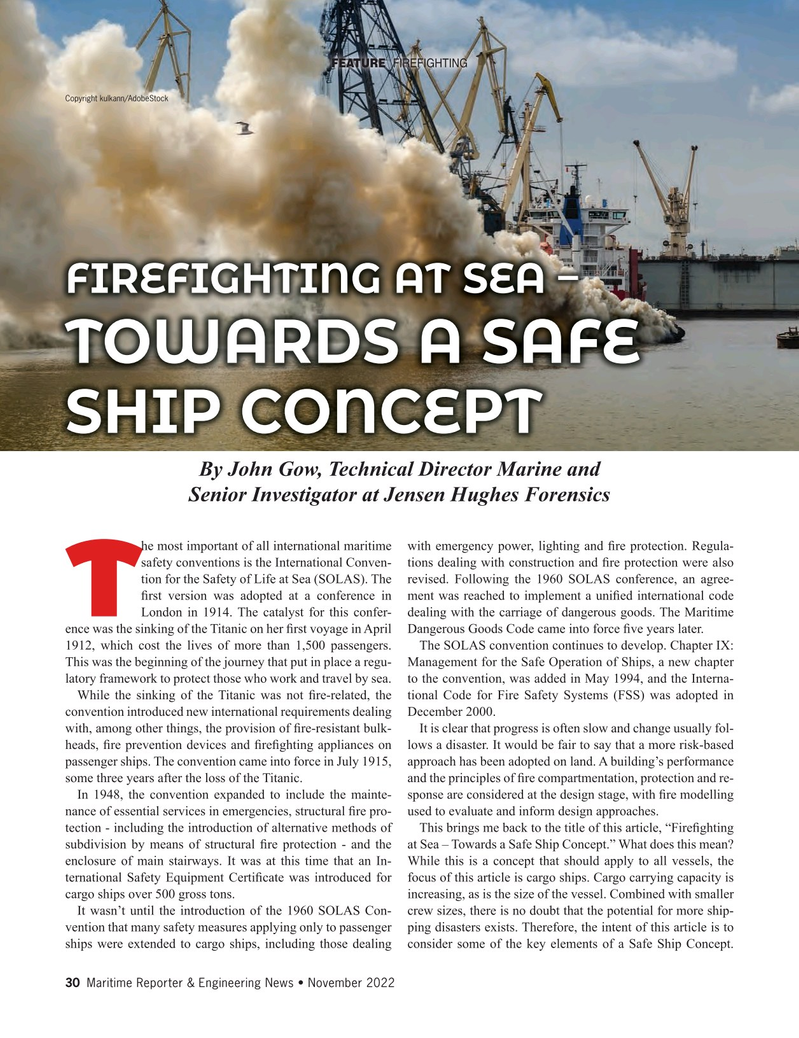
Page 30: of Maritime Reporter Magazine (November 2022)
The Workboat Edition
Read this page in Pdf, Flash or Html5 edition of November 2022 Maritime Reporter Magazine
FEATURE FIREFIGHTING
Copyright kulkann/AdobeStock
FIREFIGHTING AT SEA –
TOWARDS A SAFE
SHIP CONCEPT
By John Gow, Technical Director Marine and
Senior Investigator at Jensen Hughes Forensics he most important of all international maritime with emergency power, lighting and ? re protection. Regula- safety conventions is the International Conven- tions dealing with construction and ? re protection were also tion for the Safety of Life at Sea (SOLAS). The revised. Following the 1960 SOLAS conference, an agree- ? rst version was adopted at a conference in ment was reached to implement a uni? ed international code
TLondon in 1914. The catalyst for this confer- dealing with the carriage of dangerous goods. The Maritime ence was the sinking of the Titanic on her ? rst voyage in April Dangerous Goods Code came into force ? ve years later.
1912, which cost the lives of more than 1,500 passengers. The SOLAS convention continues to develop. Chapter IX:
This was the beginning of the journey that put in place a regu- Management for the Safe Operation of Ships, a new chapter latory framework to protect those who work and travel by sea. to the convention, was added in May 1994, and the Interna-
While the sinking of the Titanic was not ? re-related, the tional Code for Fire Safety Systems (FSS) was adopted in convention introduced new international requirements dealing December 2000.
with, among other things, the provision of ? re-resistant bulk- It is clear that progress is often slow and change usually fol- heads, ? re prevention devices and ? re? ghting appliances on lows a disaster. It would be fair to say that a more risk-based passenger ships. The convention came into force in July 1915, approach has been adopted on land. A building’s performance some three years after the loss of the Titanic. and the principles of ? re compartmentation, protection and re-
In 1948, the convention expanded to include the mainte- sponse are considered at the design stage, with ? re modelling nance of essential services in emergencies, structural ? re pro- used to evaluate and inform design approaches.
tection - including the introduction of alternative methods of This brings me back to the title of this article, “Fire? ghting subdivision by means of structural ? re protection - and the at Sea – Towards a Safe Ship Concept.” What does this mean? enclosure of main stairways. It was at this time that an In- While this is a concept that should apply to all vessels, the ternational Safety Equipment Certi? cate was introduced for focus of this article is cargo ships. Cargo carrying capacity is cargo ships over 500 gross tons. increasing, as is the size of the vessel. Combined with smaller
It wasn’t until the introduction of the 1960 SOLAS Con- crew sizes, there is no doubt that the potential for more ship- vention that many safety measures applying only to passenger ping disasters exists. Therefore, the intent of this article is to ships were extended to cargo ships, including those dealing consider some of the key elements of a Safe Ship Concept. 30 Maritime Reporter & Engineering News • November 2022
MR #11 (18-33).indd 30 11/3/2022 2:34:22 PM

 29
29

 31
31
